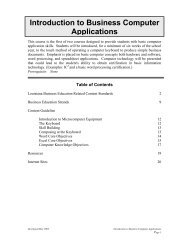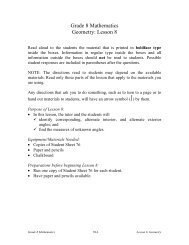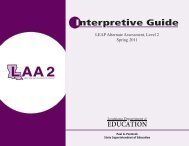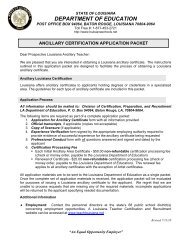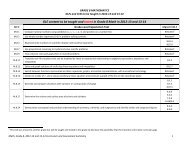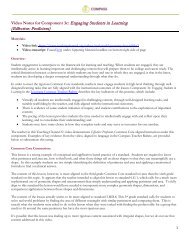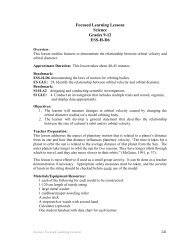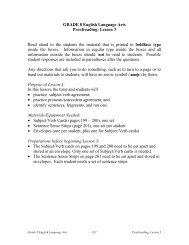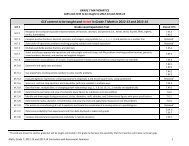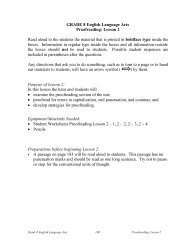School Improvement - Louisiana Department of Education
School Improvement - Louisiana Department of Education
School Improvement - Louisiana Department of Education
Create successful ePaper yourself
Turn your PDF publications into a flip-book with our unique Google optimized e-Paper software.
Step 5: Identify weakest/strongest subgroup for current year<br />
• Look for the lowest/highest index score for all subgroups (Indian, Asian/Pacific Islander, Black,<br />
Hispanic, White, LEP, Economically Disadvantaged, and Students with Disabilities) for the<br />
current year for ELA, Reading, Math, Science, and Social Studies.<br />
• If the current year lowest/highest index scores have been low/high for the past few years (ex:<br />
2006‐2008), then it should be noted as a potential weakness/strength.<br />
Step 6: Identify achievement gap issues<br />
• Compare each subgroup’s index score to the Whole <strong>School</strong> or other subgroup index score in<br />
ELA, Reading, Math, Science, and Social Studies and evaluate subgroup performance (ex: Are<br />
any subgroups consistently below/above the Whole <strong>School</strong> pr<strong>of</strong>iciency score in ELA, Reading,<br />
Math, Science, and Social Studies?).<br />
• NOTE: Be sure to look at data across all years before concluding that a subgroup<br />
weakness/strength exists.<br />
• If any subgroup index score is consistently or substantially lower/higher than the Whole <strong>School</strong><br />
or other subgroup index score and/or pr<strong>of</strong>iciency rates, then it should be noted as a potential<br />
weakness/strength.<br />
PERCENT PROFICIENT – GRADE LEVEL AND SUBGROUP TREND DATA ANALYSIS<br />
Step 7: Identify any grade level weaknesses/strengths<br />
• Compare grade level pr<strong>of</strong>iciency rates and evaluate grade level performance (ex: Does one<br />
grade have substantially lower/higher percent Pr<strong>of</strong>icient scores than all other grades?). NOTE:<br />
Be sure to look at data across all years before concluding that a grade level weakness/strength<br />
exists.<br />
• If any grade level percent Pr<strong>of</strong>icient score is consistently lower/higher than other grade percent<br />
Pr<strong>of</strong>icient scores in the school, then it should be noted as a potential weakness/strength.<br />
Step 8: Identify weakest/strongest subgroup area for current year by grade level<br />
• Look for the lowest/highest subgroup (Indian, Asian/Pacific Islander, Black, Hispanic, White, LEP,<br />
Economically Disadvantaged, Students with Disabilities) percent Pr<strong>of</strong>icient score across all grade<br />
levels for the current year for ELA, Reading, Math, Science, and Social Studies.<br />
• If the current year lowest/highest percent Pr<strong>of</strong>icient score has been low/high for the past few<br />
years, then it should be noted as a potential weakness/strength.<br />
Step 9: Identify any declining/improving trends for subgroups by grade level<br />
• Look for subgroup percent Pr<strong>of</strong>icient scores in ELA, Reading, Math, Science, and Social Studies<br />
that have declined/improved within grade levels over the past few years. NOTE: Some declining<br />
trends may be the result <strong>of</strong> population shifts and may not necessarily reflect problematic areas.<br />
• If any subgroup percent Pr<strong>of</strong>icient scores have steadily or substantially declined/improved over<br />
the past few years, then it should be noted as a potential weakness/strength.<br />
129



